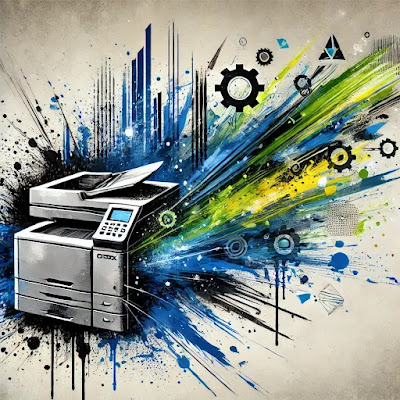Xerox.
That name used to mean something. It meant every office you walked into had the same reliable, slightly greasy machine in the corner—the hum of paper moving through rollers, toner dust filling the air, and the glow of fluorescent lights casting shadows over a maze of cubicles. For a long time, the copier was as much a fixture as the water cooler, the breakroom coffee pot, or the company fridge with someone's yogurt. But times change, and so do the tools we rely on. Now, Xerox is shedding nearly 3,000 jobs—about 15% of its workforce—as it leans into a future that has little room for the copier’s slow, mechanical heart.
This isn’t just a few job cuts here and there. It’s a gutting, a purge, and it marks a moment for Xerox—a crossroads, if you will. The company is pivoting from the print-first legacy that defined it and diving headfirst into digital and IT services. Gone are the days of copiers and stacks of paper. What Xerox is saying, loud and clear, is that it’s ready to move on. But that’s a hard pill to swallow when you’re the company that, once upon a time, was the office.
So, Why the Bloodbath?
Xerox’s CEO, Steven Bandrowczak, calls it a “reinvention.” Fancy word for a deep cut. With the world moving faster and faster into hybrid work, digital solutions, and a future where the printed page is a relic, Xerox is shifting to survive. The copier isn’t coming back. It’s no longer what keeps the lights on. And so, Xerox is building a leaner machine—stripping down, focusing on digital services, and simplifying its global operations. They’re pulling back from hardware, from the whir and hum, and embracing the cold efficiency of the cloud. This is Xerox today: sleeker, digital, a little corporate-cold, but adaptable.
Bandrowczak’s vision is a Xerox with a new mission, one that’s all about global business services and tech solutions. Streamlining isn’t enough; it’s about survival now, about clawing back some relevance in a market that’s increasingly indifferent to the big, clunky copier in the corner. Xerox wants to go all in on digital transformation, and it’s betting that by slicing away at its old identity, it can find something new, something people actually need.
A Market That’s Shrugging
Not everyone’s thrilled about this transformation. Investors reacted the way they always do—with a quick sell-off. Xerox shares dropped nearly 11% the day the layoffs hit the news. When a company lets go of this many people, it means one thing: they’re getting desperate, but they’re also getting real. They’re embracing the idea that they aren’t the Xerox people once knew. It’s risky, sure. But it’s also what a company has to do if it’s going to make it in a world that left copiers behind.
Think about it: Xerox, the company that built its empire on making paper copies, is now tearing itself apart to stay relevant in a market that has already moved on. They’re promising transition support for laid-off employees, which sounds nice. But in reality, it’s the kind of support that’s there to ease the guilt. For Xerox, this is just the start of cutting out what doesn’t fit the vision anymore.
Reinvention, or Just an Endgame?
This isn’t the first time Xerox has tried to reinvent itself. Remember when they tried to merge with Fujifilm? Or that ambitious, if doomed, attempt to take over HP? Xerox has always wanted to be more than “just a copier company.” Now, it’s throwing everything into a new identity that’s all about “digital services” and IT solutions. And they’ve set their sights on $300 million in operating income by 2026, as if that figure alone will be proof that this “reinvention” is working.
Here’s the thing: Xerox isn’t just trimming the fat. It’s gutting itself to survive in a world that doesn’t need what it used to offer. Sure, it’s bold. But it’s also a reminder that even giants have to evolve or fade out entirely. In a few years, people might not even recognize Xerox’s name, except maybe as a faint memory of that reliable copier in the corner of the office. For the people who still believe in Xerox, this is their last stand, a battle for survival in a digital world that’s cold, fast, and unforgiving.
So, What Happens Now?
For Xerox, this is as much an identity crisis as it is a strategic shift. The copier—the very thing that once defined Xerox—is now just baggage, a relic of a different time. This is a company that wants to shed its old skin, to become something that feels sleek, modern, even necessary in today’s digital-first world. And maybe they can pull it off. Maybe Xerox can become a contender in the IT world, offering cloud services and managed solutions with the same ease it once delivered stacks of paper.
But the real question is whether Xerox can find its footing fast enough to matter in this space. Because this market? It’s brutal, with tech giants who were digital from day one. Xerox is the newcomer now, the outsider, trying to find a place at a table already crowded with faster, nimbler players. For Xerox’s workforce, this shift isn’t just about a company restructuring; it’s a complete upheaval of everything the company used to be.
It’s the end of an era, and for Xerox, it’s a jump into the unknown. Whether this “reinvention” is a brilliant pivot or the company’s last desperate gasp is something only time will tell. But here they are, cutting deep, letting go of people and machines that built their legacy, hoping to create something new.
They’re walking away from the copier’s heyday, from everything that once defined Xerox. And as they look toward an uncertain future, it’s hard not to think of those machines, now silent, as the last true witnesses to a different age of work.


No comments:
Post a Comment